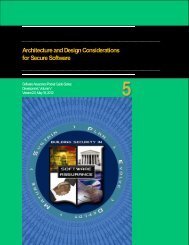Secure Coding SwA Pocket Guide - Build Security In - US-CERT
Secure Coding SwA Pocket Guide - Build Security In - US-CERT
Secure Coding SwA Pocket Guide - Build Security In - US-CERT
You also want an ePaper? Increase the reach of your titles
YUMPU automatically turns print PDFs into web optimized ePapers that Google loves.
Review Code During and After <strong>Coding</strong>The main objective of security code reviews is to discover security flaws and to identify their potential fixes. The test reportshould provide enough detailed information about software’s possible failure points to enable its developer to classify andprioritize the software’s vulnerabilities based on the likelihood of being exploited by hackers. The application guide (discussedabove) should contain a checklist of issues to consider when reviewing code. This will ensure that the code being reviewed willbe subject to the documented criteria and not the possible bias of the reviewer.Tips for a <strong>Secure</strong> Code Review» When to review: Code should be reviewed as it is written to locate flaws within individual units/modules after acceptingthem into the software that will be delivered into the software configuration management system (such as GIT or Mercurial).Programmers should also look for flaws in interfaces between units/modules before submitting those units/modules forcompilation and linking. Source code analysis and white box testing should be performed as early and as often in the lifecycleas possible. The most effective white box tests are performed on individual modules or functional-process units thatcan be corrected relatively easily and quickly before they are added into the larger code base. The whole-system codereview should focus on the relationships among and interfaces between components.» Peer review: Programmers should have other programmers on the project review their code. It is easy for programmers tomiss their own mistakes [Grembi 2008].» Tool use: Static, dynamic, and binary analysis tools can be used to find common vulnerabilities. (e.g., Microsoft offers freedownloads of FxCop, which is a static analysis tool, BinScope Binary Analyzer, and Mini-Fuzz File Fuzzer.) These tools canproduce large amounts of false positives/negatives and should be used in addition to a manual review, not as areplacement.» Reviewer competence: A manual review is only useful if the reviewers are aware of security issues. At a minimum, theyshould be aware of the vulnerabilities and mitigations for C/C++ (or whichever language the project is being coded in),databases, web applications, and cryptography [SAFECode 2008].» Leveraging test cases: The programmer should create some general test cases. Testing is not the point of the review butshould help point out obvious vulnerabilities [Grembi 2008]. It can also be a chance to test basic abuse cases.» Threat model review: The secure code review should include a review of the threat model documentation to ensure thatidentified threats are appropriately handled before code release.» Follow standards: The secure code review should ensure adherence to all coding standards, including use of securefunction libraries and removal of deprecated and banned functions.What to Look for During a <strong>Secure</strong> Code Review» All components should follow the same framework and the defined coding style [Grembi 2008].» Look for developer backdoors, debug commands, hard-coded credentials, sensitive comments in code, overly informativeerror messages, etc. These are elements added to the source code to make it easier for the developer to alter thesoftware’s state while testing. They might be exploitable after the software has been compiled and deployed. Thedevelopers should avoid using these elements in the first place unless absolutely necessary.» During system execution, look for any unused calls and code that doesn’t accomplish anything. They can include callsinvoking environment-level or middleware-level processes or library routines that are not expected to be present in theinstalled target environment.» Also look for indicators of malicious code. For example, if the code is written in C, the reviewer might seek out commentsthat indicate exploit features or portions of code that are complex, hard to follow, or contain embedded assembler code(e.g., the _asm_ feature, strings of hexadecimal or octal characters/values). All identified bugs should be examined for thepotential of exploitation. Bugs that can be exploited are security bugs and should be treated specifically prior to coderelease.Software Assurance <strong>Pocket</strong> <strong>Guide</strong> Series:Development Volume VI – Version 2.0, , May 18, 2012<strong>Secure</strong> <strong>Coding</strong>12
















